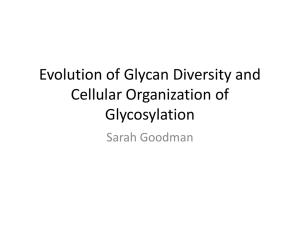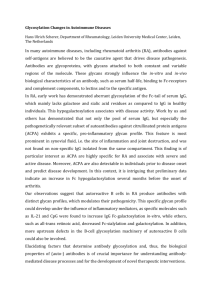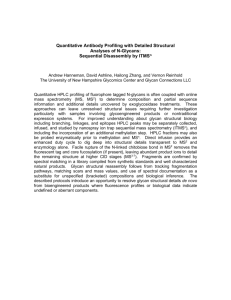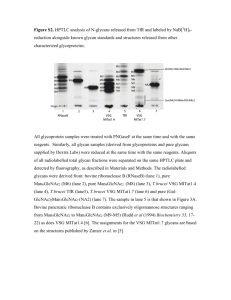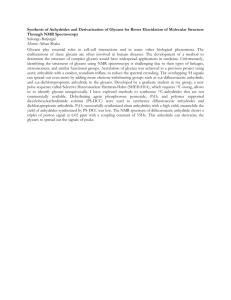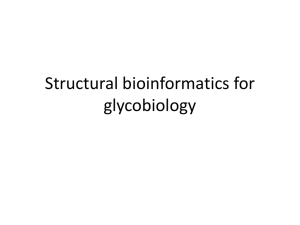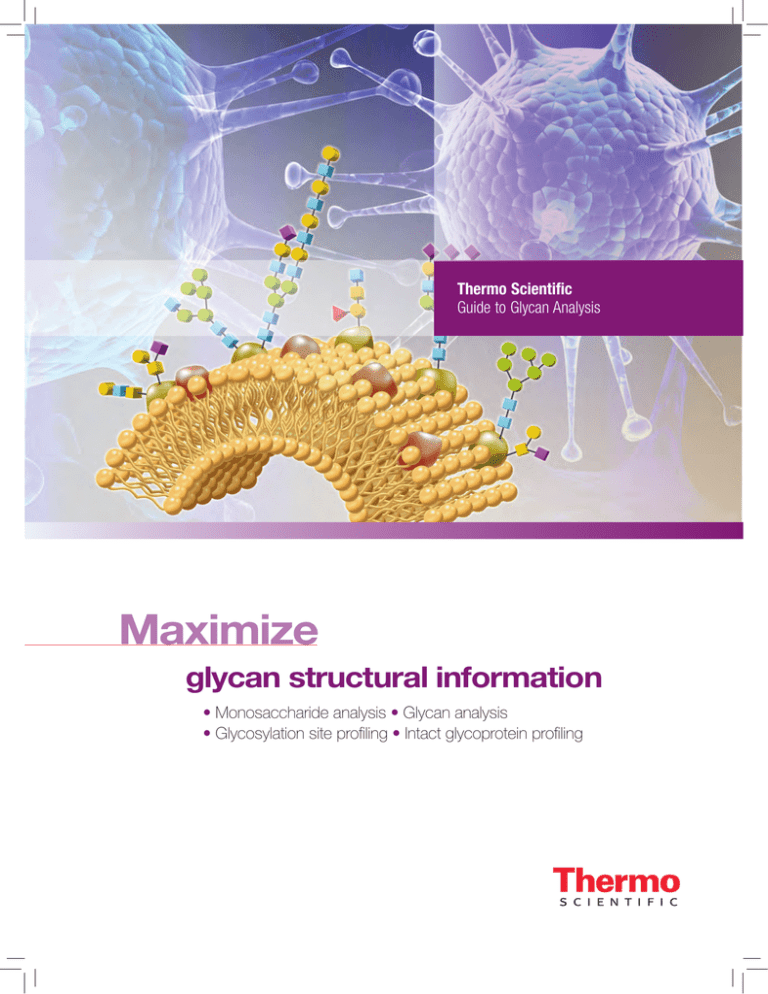
Thermo Scientific
Guide to Glycan Analysis
Maximize
glycan structural information
• Monosaccharide analysis • Glycan analysis
• Glycosylation site profiling • Intact glycoprotein profiling
Glycan Analysis Overview
Glycosylation is one of the most important post-translational modifications of eukaryotic cell proteins.
Glycan-modified proteins are involved in a wide range of biological and physiological processes including
recognition and regulatory functions, cellular communication, gene expression, cellular immunity, growth,
and development.
Glycan functions are often dependent on the structure of the oligosaccharide. Oligosaccharides are covalently
attached to proteins primarily through two structural motifs: attached to the amide group of an asparagine,
referred to as “N-linked glycans,” or attached to the hydroxyl group on serine or threonine, referred to as
“O-linked glycans”. Both types of glycans are investigated as biomarkers, in order to understand changes
related to complex organelle development, and as part of therapeutic protein drug development with strong
indication that efficacy is affected by glycosylation.1 Agencies such as the United States Food and Drug
Administration (U.S. FDA) and the European Medicines Agency have published documents recommending
that biopharmaceutical manufacturers demonstrate satisfactory programs for understanding, measuring, and
controlling glycosylation in glycoprotein-based drugs, with recent updated draft guidance from the U.S. FDA
for characterization of biosimilar protein therapies.2 This guidance suggests that the oligosaccharide content of
glycoprotein products should be understood and monitored to ensure product consistency.
Many analytical approaches have been employed in the area of glycan and glycoproteomics research, which
can be generally summarized under the following categories:
•Monosaccharide analysis
• Glycan analysis
• Glycosylation site profiling
• Intact glycoprotein profiling
These analyses are performed to determine the identity and quantity of the carbohydrates present, the
post-translational modification site, and the multiple glycoforms of a protein that may be present. Choosing the
appropriate analysis technique depends on experimental demands and instrumental capabilities. This handbook
is intended to assist the decision-making process.
2
Glycoprotein
Glycopeptides
Intact Glycoprotein
Glycosylation Site Profiling
Intact Glycoprotein Profiling
Glycosylation
Site Profiling
with MS
Intact
Glycoprotein
Profiling with MS
Released Glycans
Monosaccharide Analysis
Neutral
Monosaccharide
Analysis
with HPAE-PAD
Charged
Monosaccharide
Analysis
with HPAE-PAD
Glycan Analysis
Glycan Analysis
with HPAE-PAD
Glycan Analysis
with HPLC-FD
Glycan Analysis
with MS
Glycan
Identification and
Characterization
Glycan
Quantification
Carbohydrate: A generic term used interchangeably with sugar, oligosaccharide, or glycan. This term includes monosaccharides,
oligosaccharides, and polysaccharides as well as derivatives of these compounds.
CID: collision-induced dissociation
CDG: congenital disorders of glycosylation
ESI: electrospray ionization
ETD: electron transfer dissociation
FD: fluorescence detection
Glycan: A generic term for any sugar or assembly of sugars, in free form or attached to other molecules such as proteins and lipids.
GU: glucose unit
HCD: higher-energy collisional dissociation
HILIC: hydrophilic interaction liquid chromatography
HPAE-PAD: high-performance anion-exchange chromatography with pulsed amperometric detection
HPLC: high-performance liquid chromatography
HR/AM: high-resolution accurate-mass
LC/MS: liquid chromatography mass spectrometry
Monosaccharides: The simplest form of a glycan. It cannot be hydrolyzed into simpler units. Building block of glycans.
Common examples include glucose, fucose, galactose, glucosamine, sialic acids, etc.
MS: mass spectrometry
MS/MS: tandem mass spectrometry
MSn: multi-stage fragmentation
Oligosaccharides: A glycan polymer, consisting of two or more monosaccharides.
PGC: porous graphitic carbon
RP: reversed-phase
WAX: weak anion exchange
3
Monosaccharide Analysis
Characterization of glycoproteins routinely involves glycan analysis to monitor
variations in glycosylation, which can impact the efficacy of protein therapeutics.
Monosaccharide composition analysis can screen for changes in glycosylation
relative to a reference protein as well as quantify the amounts of individual
monosaccharides, most often fucose, galactosamine, glucosamine, galactose,
glucose, and mannose.
Neutral Monosaccharide Analysis with HPAE-PAD
Monosaccharides are usually thought to be non-ionic. However,
they are weak acids, and under basic conditions, pH 12-14,
the carbohydrates are either partially or completely ionized and
thus can be separated by anion-exchange chromatography.
This chromatographic approach is well suited to base-stable
polymer anion-exchange columns exemplified by the Thermo
Scientific™ Dionex™ CarboPac™ columns. By combining this
high-resolution anion-exchange separation with electrochemical
detection, a sensitive and specific analytical method,
HPAE-PAD, is possible.
Samples are acid hydrolyzed to release the monosaccharides,
lyophilized, dissolved in water, and then analyzed by
HPAE-PAD. This direct analysis method easily resolves, and
allows quantification of, individual glycan monosaccharides,
providing not only the total glycosylation of a protein, but
also the amounts of specific monosaccharides. For example,
this analysis provides details about fucosylation, which can
impact protein function and signaling, gives an indication of
the presence of O-linked glycans by monitoring changes in
galactosamine content, and determines mannose content as an
indication of high-mannose N-linked glycans, which have been
investigated as cancer biomarkers.
ACQUIRE DATA:
RELEASE:
Monosaccharides are dissolved in
deionized water, then analyzed by
HPAE-PAD
Monosaccharides are released
by acid hydrolysis
SAMPLE:
Glycans come from a
variety of sources
REMOVE ACID:
Hydrolyzates are lyophilized
to remove residual acid
ANALYZE DATA:
Monosaccharides are quantified by
comparison to a standard curve
Tissue
Tisssue Culture
Cell Culture
Antibody
Protein
Workflow for monosaccharide analysis using HPAE-PAD
4
Glycan analys
Charged Monosaccharide Analysis with HPAE-PAD
Glycoprotein sialylation has been shown to be critical to
bioavailability, stability, metabolism, and immunogenicity of
therapeutic proteins.3 Although over 50 forms of sialic acid
have been identified, two forms of this carbohydrate are
routinely determined: N-acetylneuraminic acid (Neu5Ac)
and N-glycolylneuraminic acid (Neu5Gc). Of these, Neu5Gc
is generally not found in human proteins and is potentially
immunogenic. After release, sialic acids may be determined
by two liquid chromatographic methods: HPAE-PAD or
derivatization followed by HPLC with fluorescence detection.
To analyze samples without derivatization, HPAE-PAD may
be used. A rapid method has been published to determine
the two most abundant sialic acids, Neu5Ac and Neu5Gc, in
glycoprotein hydrolyzates.4 Determination of sialic acids by
derivatization followed by HPLC typically uses 1,2-diamino4,5-methylenedioxybenzene dihydrochloride (DMB) to modify
the sialic acid after release from the glycoprotein to provide a
fluorescent product.5-6 This HPLC method allows separation of a
wider variety of modified sialic acids.
D-Mannose-6-phosphate (M-6-P) is a terminal monosaccharide
of N-linked oligosaccharides that is an important intermediate
in glycoprotein production and, when incorporated in the
glycoprotein's final oligosaccharide, is needed for targeting and
recognition on some lysosomal proteins. Genetic glycosylation
defects or malfunctions in the synthesis or processing of
protein-bound oligosaccharides are known collectively as
CDG. Studies of M-6-P–containing glycoproteins and M-6-P
receptors are active areas for medical research with the goals
of understanding and hopefully treating or controlling these
and other diseases. After release from proteins, M-6-P is
determined by HPAE-PAD.7-8
5
Glycan Analysis
Although determining monosaccharide content in glycoproteins provides significant
information, knowledge of glycan structure is valuable. Glycan analysis enables
monitoring of relative quantities of a particular set of glycans. Additionally it can
provide valuable information regarding changes in glycan patterns or identify
aberrant glycans. Due to the complexity of a glycan structure, structural elucidation
is performed after release of glycans from a protein. The preferred form of release
for N-linked glycans is by enzymatic means. This can be done by treating the
N-linked glycan with peptide-N-glucosidase F (PNGaseF). PNGaseF releases most
glycans except those that contain 1-3 linked fucose to the reducing terminal
GlcNAc. In that case, the enzyme peptide-N-glucosidase A (PNGaseA) is used.
Unfortunately, there are no enzymes comparable to PNGAseF that release O-linked
glycans. Instead, the preferred approach for the release of O-linked glycans
is the use of chemical methods such as β-elimination. Once released, these
oligosaccharides, both neutral and charged, can by analyzed by several methods
to provide detailed information.
Glycan Analysis with HPAE-PAD
HPAE–PAD is a well-established glycan analysis method that
separates carbohydrates with specific interactions between the
hydroxyl and carboxyl groups of glycans, which are charged
at high pH, and the stationary phase. This separation resolves
glycans based on charge, size, composition, isomers, and
linkages, and provides a profile of the overall glycosylation and
individual glycans. This method is capable of separating glycans
based on sialic acid linkage, providing valuable information not
only about the carbohydrate sequence of a glycan, but also
the subtle linkage differences that may indicate disease states.
With comparison to standards, this method can provide detailed
information about released neutral and charged glycans with
direct detection of glycans.9-10
RELEASE:
ACQUIRE DATA:
Glycans are released by enzymatic
or chemical means, depending on
the type of glycosylation
SAMPLE:
Glycans come from a
variety of sources
Glycans are analyzed
by HPAE-PAD
ISOLATE:
Released glycans are isolated,
desalted, and any denaturants
are removed
ANALYZE DATA:
Glycans are identified by comparison
to retention time standards
Tissue
Tiss
sue Culture
Cell Culture
6
Antibody
Protein
Workflow for glycan analysis using HPAE-PAD
Glycan Analysis with HPLC-FD
Analysis of glycans by HPLC has gained significant interest in
recent years. HPLC-based glycan analysis can be categorized
by the chosen detection method and the detail in the
information sought. Most commonly, fluorescence-based
detectors or mass spectrometers are used for detection of
HPLC-separated glycans. The following section will highlight the
HPLC methodology in conjunction with fluorescence detection.
Glycans do not contain fluorophores and thus must be labeled
with fluorescent tags prior to analysis. Labeling is performed
at the reducing end of the glycan by reductive amination, with
the most common labels being 2-aminobenzamide (2-AB) or
2-aminobenzoic acid (2-AA).11-13 HPLC-based methods have
been applied with fluorescent-labeled oligosaccharides for
the separation of sialylated and neutral glycans from various
biological samples, recombinant therapeutic proteins, growth
hormones, etc. The three most commonly used column
chemistries are RP, WAX, and HILIC. HILIC columns are the
most widely used for glycan analysis. These columns separate
sialylated and neutral glycans in one chromatographic run,
providing an advantage for rapid glycan profiling. However,
HILIC columns don't separate based on charge and isomers
as compared to HPAE-PAD analysis — and reduction
amination methods produce some desialylation of the released
oligosaccharides. A typical workflow compares the elution of
2-AB-labeled glycans against a 2-AB-labeled dextran ladder.
The individual peaks from the glycan profile are then assigned
a GU based on comparison to the dextran ladder. This value
is correlated to glycan structures that have been previously
determined. Once potential structures are identified, they are
confirmed with a series of exoglycosidase digestions.
Alternatively, if a mixture of known standards is available, these
standards can be analyzed under the same chromatographic
conditions as the samples. The number of peaks and their
area under the curve can then be used for qualitative and
quantitative estimation of the unknown N-linked glycans.
However, if there are completely unknown glycans present, they
can be identified by MS after LC separation.
RELEASE:
LABEL:
Glycans are released by enzymatic
or chemical means, depending on
the type of glycosylation
SAMPLE:
Glycans come from a
variety of sources
Glycans must be labeled
with fluorescent tags
ISOLATE:
Released glycans are isolated,
desalted, and any denaturants
are removed
ACQUIRE DATA:
Glycans are analyzed
by HPLC-FD
ANALYZE DATA:
Chromatograms can be
processed by Thermo Scientific™
Chromeleon™ software
Tissue
Tisssue Culture
Cell Culture
Antibody
Protein
Workflow for glycan analysis using HPLC-FD
7
Glycan Analysis
Glycan Analysis with MS
Mass spectrometry has emerged as one of the most powerful
tools for the structural elucidation of glycans due to its
sensitivity, small sample requirement, and ability to analyze
complex glycan mixtures. In addition to the characterization
of the glycan sequence, MS provides branching patterns,
substituent location, and quantitative information.
and reductively aminated glycans.21,22 PGC is typically used
for O-linked glycans. For reductively aminated glycans, the
preferred label for PGC separation is 2-aminopyridine (PA).
PGC also can separate structural isomers. For MS, the benefit
of reducing-end tags is that they localize the charge at the
reducing end of the glycan, resulting in predominantly X,Y, and
Z fragmentation ions for CID or HCD fragmentation23—greatly
simplifying the structure analysis of unknowns.
Glycan identification and characterization
Due to the weak acidity or basicity of most glycans, free
glycans do not ionize efficiently. Therefore, it is necessary to
derivatize glycans prior to MS analysis. Derivatization methods
can be classified into two categories: labeling reducing ends
and protecting functional groups. Reducing-end labeling is
performed by reductive amination where the most common
label is 2-AB. Protection of most or all functional groups is
performed by permethylation.14-17
Reductively aminated glycans are suitable for HILIC-based
separation prior to MS analysis.18-20 HILIC uses both glycan size
and structure in separation, thus providing the additional benefit
of separating structural isomers. HILIC can also separate
native glycans.19,20 The Thermo Scientific™ GlycanPac™ AXH-1
column separates labeled and unlabeled glycans using its
mixed-mode surface chemistry combining WAX and HILIC
retention mechanisms. The WAX functionality provides retention
and selectivity for negatively charged glycans while the HILIC
mode facilitates the separation of glycans of the same charge
according to their polarity and size. A PGC stationary phase is
also employed for glycan separation as it can separate native
RELEASE:
Glycans come from a
variety of sources
Data analysis is a critical part of MS-based glycan analysis
workflows. SimGlycan® software from PREMIER Biosoft enables
interpretation of MS/MS and MSn data generated on Thermo
Scientific mass spectrometers.24-26
LABEL (optional):
Glycans are released by enzymatic
or chemical means, depending on
the type of glycosylation
SAMPLE:
Alternatively, the protection of most or all functional groups can
be selected as a derivatization method. The most common of
these, permethylation, improves the MS ionization response of
all free glycans equally. This enables simultaneous analysis of
both neutral and acidic glycans. Furthermore, permethylation
increases the occurrence of cross-ring and double glycosidic
cleavages during fragmentation, which is important in
assessing linkage and branching information. A workflow
combining permethylation and MSn has been developed. This
approach enables detailed determination of glycan linkages
and branching information important for structural isomer
differentiation.16,17,24 Permethylated glycans can also be
separated prior to analysis by MS, employing either RP or PGC.
Glycans can be labeled
or unlabeled
ISOLATE:
Released glycans are isolated,
desalted, and any denaturants
are removed
ACQUIRE DATA:
Glycans are analyzed by direct
infusion MS/MS, MSn or LC-MS/MS
ANALYZE DATA:
Glycans are identified by CID or
HCD fragmentation spectra
Tissue
Tisssue Culture
Cell Culture
Antibody
Protein
Workflow for glycan identification and characterization using mass spectrometry
8
Glycan quantification
Glycan quantification has witnessed a number of method
developments in recent years.27,28 One powerful and widely
used approach takes advantage of reductive amination to
introduce stable isotope labels onto the glycans. Similar to
the 2-AB label used in glycan characterization, the 2-AA label
offers many of the same benefits for LC-MS analysis. However,
it is also available commercially in stable, isotopically labeled
forms, 2-12[C6]-AA and 2-13[C6]-AA, and can be used for
relative quantification experiments.29
in a predictable manner leading to abundant ions that can
be assigned unambiguously. Generally, 2-AA quantification
experiments are performed by LC-MS. Because the glycans
are derivatized with isotopic labels, they behave similarly within
the separation stage (coeluting at the same time) but can
easily be differentiated by a mass spectrometer owing to the
mass differences of the two isotope labels (6 Da between the
12
[C6] and 13[C6] isotopic pair). The relative peak intensities of
multiple isotopically distinct glycans are used to determine the
average change in glycan abundance in the treated sample.
The unmatched resolution and mass accuracy afforded by
Thermo Scientific™ Orbitrap™ technology provide discrimination
between co-eluting isobaric ions, which is essential for
correct 2-AA quantification. Additionally, since quantification is
dependent upon precursor ions, CID, ETD, or HCD can be used
for structural elucidation.
In stable isotopic 2-AA labeling experiments, glycans are
released from proteins by enzymatic means and differentially
labeled in parallel with either the 2-12[C6]-AA or 2-13[C6]-AA
fluorescent tag. After labeling, samples are combined so
that subsequent processing steps can be performed on the
combined samples, greatly reducing sample handling variability
and resulting in more accurate quantification. The equimolar,
differentially labeled, paired sample is then subjected to direct
infusion or LC-MS-based relative quantitative analysis.
Data analysis of 2-AA experiments requires both glycan
quantification and structural elucidation.
Labeling with reductive amination tags such as 2-AA provides
a number of benefits for MS analysis: 1) enhanced ionization
increases efficiency in the negative ion mode, 2) labeling can
be undertaken under aqueous conditions with no prior sample
work-up, and 3) fragmentation of the labeled glycan occurs
Quantification is performed at the MS level by comparing
the intensities of the 2-12[C6]-AA- and 2-13[C6]-AA-labeled
precursor ions at high resolution.
2-12[C6]-AA
2-12[C6]-AA
2-13[C6]-AA
2-13[C6]-AA
2-13[C6]-AA
2-12[C6]-AA
RELEASE:
COMBINE:
Glycans are released by enzymatic
or chemical means, depending on
the type of glycosylation
SAMPLE:
Equal sample amounts are
combined to create one sample
LABEL:
Glycans come from a
variety
i t off sour
rces
sources
Released glycans are isotopically
labeled with either 2-12[C6]-AA or
2-13[C6]-AA
ACQUIRE DATA:
Glycans are analyzed by direct
infusion MS/MS, MSn or LC-MS/
LC-MS/MS
ANALYZE DATA:
Glycans are identified by CID or
HCD fragmentation spectra
Tissue
Tisssue Culture
Cell Culture
2-12[C6]-AA
2-12[C6]-AA
2-12[C6]-AA
Antibody
Protein
2-13[C6]-AA
2-13[C6]-AA
2-13[C6]-AA
Workflow for glycan quantification using mass spectrometry
9
Glycosylation Site Profiling
Glycosylation Site Profiling with MS
Glycans can also be profiled at the peptide level, such that
relative quantification of specific glycosylation sites is achieved.
Sample enrichment is central to the success of this workflow
by reducing overall sample complexity and facilitating sensitive,
accurate analysis. The enrichment steps can be carried out at
the protein level, peptide level, or both levels. The enrichment
can be targeted or universal, depending on the nature of
information sought. Targeted enrichment may be performed
to selectively isolate a certain subset of glycopeptides or
glycoproteins on the basis of specific glycan structures (e.g.,
the use of titanium dioxide to isolate sialylated glycopeptides).
In recent years, much emphasis has been placed on developing
bioinformatics tools to simplify interpretation of glycopeptide
data. The recent development of a novel software tool,
Byonic™ by Protein Metrics™, alleviates many of the hurdles
accompanying manual interpretation. Byonic software uses
data from both types of fragmentation: HCD data to identify the
sugar composition and the corresponding ETD data for peptide
backbone information. The final result describes the peptide
sequence, glycosylation site, and glycan composition.
Multiple fragmentation mechanisms are required for this
workflow. A combination of HCD or CID with ETD is used.
ETD provides extensive fragmentation along the peptide
backbone to enable peptide sequencing while preserving glycan
attachments, allowing glycosylation site localization. CID or HCD
provides information about the glycan composition.
ACQUIRE DATA:
ISOLATE:
Glycopeptides are analyzed by LC-MS/MS
with Orbitrap-based mass spectrometers
Glycoproteins can be
isolated by various means
SAMPLE:
Glycans come from a
sources
variety of sour
rces
ENRICH:
Glycopeptide enrichment
can be universal or targeted
ANALYZE DATA:
Glycans, glycosylation site, and
peptide sequence are identified by
fragmentation spectra
Tissue
Tisssue Culture
Cell Culture
Antibody
Protein
Workflow for glycosylation site profiling using mass spectrometry
10
g
Intact Glycoprotein Profiling
Intact Glycoprotein Profiling with MS
Over the past few years, recombinant monoclonal antibodies
(mAbs) have gained significant importance in diagnostic and
therapeutic applications. Structural features of mAbs, such as
assembly of light and heavy chains with disulfide bridges, are
commonly known. However, the heterogeneity of antibodies, in
part due to the variation of attached sugar moieties, requires
thorough characterization to verify the correctness of the
overall molecule and ensure a reproducible, safe, and effective
biological drug.
Intact glycoprotein profiling by mass spectrometry is a good
way to ascertain expected pattern and degree of glycosylation.
Due to the inherent heterogeneity and variation of the attached
glycan moieties, which divides the signal from a single core
protein among its multiple glycoforms, intact glycoprotein
profiling is best performed on a high-resolution accurate-mass
hybrid Orbitrap mass spectrometer with ESI. One of the intrinsic
advantages of ESI-MS is its ability to place multiple charges
on particular species. The multiple charging effect makes
possible the analysis of large intact proteins using conventional
mass ranges. Mass spectrometers with the highest available
resolution, mass accuracy, and scan speed are preferred
to isotopically resolve peaks for precise molecular mass
determination and quantification.
Intact glycoprotein profiling can be performed by either direct
infusion or LC/MS. For very complex samples, where the total
number of isoforms might be large, LC separation is typically
required prior to MS analysis.
Thermo Scientific™ Protein Deconvolution software takes full
advantage of the HR/AM data produced by Orbitrap-based
mass spectrometers to deconvolute the mass spectrum and
identify the degree of glycosylation.
ACQUIRE DATA:
ISOLATE:
Glycoproteins are analyzed by direct
infusion or LC-MS with Orbitrap-based MS
Glycoproteins can be
isolated by various means
SAMPLE:
Glycans come from a
variety of sour
rces
sources
REDUCE:
Glycoproteins are reduced
with dithiothreitol
ANALYZE DATA:
and
ified by
Mass spectra are analyzed to
determine MW and glycoforms
Tissue
Tisssue Culture
Cell Culture
Antibody
Protein
Workflow for intact glycoprotein profiling using mass spectrometry
11
References
1. Varki, A. Biological Roles of Oligosaccharides: All the Theories are Correct.
Glycobiology 1993, 3(2), 97–130.
2. Guidance for Industry, Scientific Considerations in Demonstrating Biosimilarity
to a Reference Product , 2012, U.S. Department of Health and Human Services
Food and Drug Administration Center for Drug Evaluation and Research (CDER)
Center for Biologics Evaluation and Research (CBER) www.fda.gov/downloads/
Drugs/GuidanceComplianceRegulatoryInformation/Guidances/UCM291128.pdf
3. Du, J.; Meledeo, M.A.; Wang, Z.; Khanna, H.S.; Paruchuri, V.D.P.; Yarema, J.K.
Metabolic Glycoengineering: Sialic Acid and Beyond. Glycobiology 2009, 19,
1382–1401.
4. Hurum, D.C.; Rohrer, J.S. Five-Minute Glycoprotein Sialic Acid Determination
by High-Performance Anion Exchange Chromatography with Pulsed Amperometric
Detection. Anal. Biochem. 2011, 419, 67-69.
5.
Hara, S.; Yamaguchi, M.; Takemori, Y.; Nakamura, M. Highly Sensitive
Determination of N-Acetyl- and N-Glycolylneuraminic Acids in Human Serum and
Urine and Rat Serum by Reversed-Phase Liquid Chromatography with
Fluorescence Detection, J. Chromatogr., B: Biomed. 1986, 377, 111–119.
6.
Hara, S.; Yamaguchi, M.; Takemori, Y.; Furuhata, K.; Ogura, H.; Nakamura, M.;
Determination of Mono-O-Acetylated N-Acetylneuraminic Acids in Human and Rat
Sera by Fluorometric High-Performance Liquid Chromatography, Anal. Biochem.
1989, 179, 162–166.
7.
Orvisky, E.; Stubblefield, B.; Long, R.T.; Martin B. M.; Sidransky, E.; Krasnewich,
D. Phosphomannomutase Activity in Congenital Disorders of Glycosylation Type
Ia Determined by Direct Analysis of the Interconversion of Mannose- 1-Phosphate
to Mannose-6-Phosphate by High-pH Anion-Exchange Chromatography with
Pulsed Amperometric Detection. Anal. Biochem. 2003, 317, 12–18.
8.
Application Note 202: High Performance Anion-Exchange Chromatography with
Pulsed Amperometric Detection (HPAE-PAD) Analysis of Mannose-6-Phosphate,
LPN 2076, 2009 [Online] www.dionex.com/en-us/webdocs/68636-AN202-ICMannose-6-Phosphate-19Mar2009-LPN2076-02.pdf (accessed 09/28/12).
9.
Hardy, M. R.; Rohrer, J. S. High-pH Anion-Exchange Chromatography (HPAEC)
and Pulsed Amperometric Detection (PAD) for Carbohydrate Analysis.
In Comprehensive Glycoscience; Kamerling, J.P., Ed.; Elsevier: Amsterdam,
The Netherlands, 2007, Vol. 2, pp 303–327.
10. Grey, C.; Edebrink, P.; Krook, M.; Jacobsson, S.P. Development of a
High Performance Anion Exchange Chromatography Analysis for Mapping of
Oligosaccharides. J. Chromatogr. B. 2009, 877, 1827-1832.
11. Chen, X.; Flynn, G.C. Analysis of N-glycans from Recombinant Immunoglobulin
G by On-line Reversed-phase High-performance Liquid Chromatography-mass
spectrometry. Anal. Biochem. 2007, 370, 147-161.
12. Melmer, M.; Stangler, T.; Schiefermeier, M.; Brunner, W.; Toll, H.; Rupprechter,
A.; Lindner, W.; Premstaller, A. HILIC Analysis of Fluorescence-labeled N-glycans
from Recombinant Biopharmaceuticals. Anal. Bioanal. Chem. 2010, 398, 905-914.
13. Prater, B.D.; Connelly, H.M.; Qin, Q.; Cockrill, S.L. High-throughput
Immunoglobulin G N-glycan Characterization Using Rapid Resolution Reverse-phase
Chromatography Tandem Mass Spectrometry. Anal. Biochem. 2009, 385, 69-79.
14. Ciucanu, I.; Kerek, F.; A Simple and Rapid Method for the Permethylation of
Carbohydrates. Carbohydr. Res. 1984, 131, 209-217.
15. Ciucanu, I.; Costello, C.E.; Elimination of Oxidative Degradation During the
per-O-methylation of Carbohydrates. J. Am. Chem. Soc. 2003, 125,
16213-16219.
16. Ashline, D. J.; Lapadula, A. J.; Liu, Y. H.; Lin, M.; Grace, M.; Pramanik, B.;
Reinhold, V. N.; Carbohydrate Structural Isomers Analyzed by Sequential Mass
Spectrometry. Anal. Chem. 2007, 79(10), 3830-42.
17. Stumpo, K.A.; Reinhold, V.N. The N-Glycome of Human Plasma J. Proteome Res.
2010, 9, 4823-4830
18. Melmer, M.; Stangler, T.; Schiefermeier, M.; Brunner, W.; Toll, H.; Rupprechter,
A.; Lindner, W.; Premstaller, A. HILIC Analysis of Fluorescence-labeled N-glycans
from Recombinant Biopharmaceuticals Anal. Bioanal. Chem. 2010,
398, 905-914
19. Bereman, M.S.; Williams, T.I.; Muddiman, D.C. Development of a nanoLC LTQ
Orbitrap Mass Spectrometric Method for Profiling Glycans Derived from Plasma
from Healthy, Benign Tumor Control, and Epithelial Ovarian Cancer Patients
Anal. Chem. 2009, 81, 1130-1136
20. Luo, Q.; Rejtar, T.; Wu, S.; Karger, B.L. Hydrophilic Interaction 10 μm I.D.
Porous Layer Open Tubular Columns for Ultratrace Glycan Analysis by Liquid
Chromatography-Mass Spectrometry J. Chromatogr. A. 2009, 1216, 1223-1231
21. Robinson, S.; Bergstrom, E.; Seymour, M.; Thomas-Oates, J Screening of
Underivatized Oligosaccharides Extracted from the Stems of Triticum Aestivum
Using Porous Graphitized Carbon Liquid Chromatography-Mass Spectrometry
Anal. Chem. 2007, 79, 2437-2445
22. Robinson, S. The Use of Porous Graphitic Carbon LC-MS for the Analysis of
Underivatised Carbohydrates from Wheat Stems Thermo Scientific Hypercarb
Columns Applications Notebook Issue 1, June 2009 pg 17-1923.
23. Domon, B.; Costello, C.E. A Systematic Nomenclature for Carbohydrate
Fragmentations in FAB-MS/MS Spectra of Glycoconjugates. Glycoconj. J.
1988, 5, 397-409
24. Saba, J.; Apte, A.; Meitei, N.S.; Viner, R., Application Note 516: Automated
Glycan Structural Isomer Differentiation Using SimGlycan Software.
www.thermoscientific.com
25. Apte, A.; Meitei, N. S., Bioinformatics in Glycomics: Glycan Characterization
with Mass Spectrometric Data Using SimGlycan. Methods Mol. Biol. 2010,
600, 269-281.
26. Schiel, J.E., Au, J., He, H. and Phinney, K.W. LC-MS/MS Biopharmaceutical
Glycoanalysis: Identification of Desirable Reference Material Characteristics
Anal. Bioanal. Chem. 2012, 403, 2279-2289.
27. Atwood 3rd, J.A.; Cheng, L.; Alvarez-Manilla, G.; Warren, N.L.; York, W.S.;
Orlando, R. Quantitation by Isobaric Labeling: Applications to Glycomics
J. Proteome Res. 2008, 7, 367–374
28. Orlando, R.; Lim, J.M.; Atwood 3rd, J.A.; Angel, P.M.; Fang, M.; Aoki, K’;
Alvarez-Manilla, G.; Moremen, K.W.; York, W.S.; Tiemeyer, M.; Pierce, M.;
Dalton, S.; Wells, L. IDAWG: Metabolic Incorporation of Stable Isotope Labels for
Quantitative Glycomics of Cultured Cells J. Proteome Res. 2009, 8, 3816-3823.
29. Prien, J.M.; Prater, B.D.; Qin, Q.; Cockrill, S.; Mass Spectrometric-based
Stable Isotopic 2-aminobenzoic Acid Glycan Mapping for Rapid Glycan
Screening of Biotherapeutics Anal. Chem. 2010, 82, 1498-1508.
www.thermoscientific.com
©2013 Thermo Fisher Scientific Inc. All rights reserved. Byonic is a trademark of Protein Metrics. SimGlycan is a registered
trademark of PREMIER Biosoft International. ISO is a trademark of the International Standards Organization. All other trademarks
are the property of Thermo Fisher Scientific Inc. and its subsidiaries. Specifications, terms and pricing are subject to change. Not all
products are available in all countries. Please consult your local sales representative for details.
Africa-Other +27 11 570 1840
Australia +61 3 9757 4300
Austria +43 1 333 50 34 0
Belgium +32 53 73 42 41
Canada +1 800 530 8447
China +86 10 8419 3588
Denmark +45 70 23 62 60
Europe-Other +43 1 333 50 34 0
Finland/Norway/Sweden
+46 8 556 468 00
France +33 1 60 92 48 00
Germany +49 6103 408 1014
India +91 22 6742 9434
Italy +39 02 950 591
Japan +81 45 453 9100
Latin America +1 561 688 8700
Middle East +43 1 333 50 34 0
Netherlands +31 76 579 55 55
New Zealand +64 9 980 6700
Russia/CIS +43 1 333 50 34 0
South Africa +27 11 570 1840
Thermo Fisher Scientific,
San Jose, CA USA is
ISO 9001:2008 Certified.
Spain +34 914 845 965
Switzerland +41 61 716 77 00
UK +44 1442 233555
USA +1 800 532 4752
BR63722_E 07/13S


